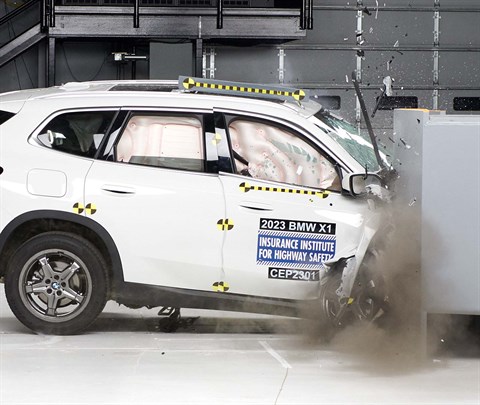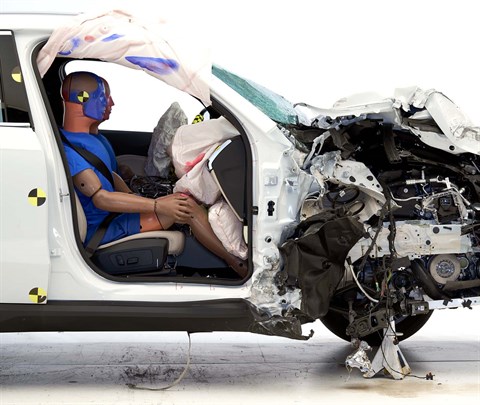Small overlap front
The small overlap front evaluation consists of a driver-side and a passenger-side component. If the results of the two evaluations differ, then the combined small overlap rating is equal to the lower rating.
Driver-side
- Rating applies to 2024-25 models
Tested vehicle: 2023 BMW X1 xDrive28i 4-door 4wd
The BMW X1 was redesigned for the 2023 model year, and the BMW X2, derived from the X1, was redesigned for the 2024 model year. Driver-side small overlap frontal ratings are assigned by the Institute based on a test of a 2023 X1 conducted by BMW.
| Evaluation criteria | Rating |
|---|---|
| Overall driver-side evaluation | |
| Structure and safety cage | |
| Driver injury measures | |
| Head/neck | |
| Chest | |
| Hip/thigh | |
| Lower leg/foot | |
| Driver restraints and dummy kinematics | |
Passenger-side
- Rating applies to 2024-25 models
Tested vehicle: 2023 BMW X1 xDrive28i 4-door 4wd
The BMW X1 was redesigned for the 2023 model year, and the BMW X2, derived from the X1, was redesigned for the 2024 model year. Two passenger-side small overlap frontal tests of the BMW X1 were conducted, one by the Institute and the other by BMW. Ratings are based on both tests, but the vehicle specifications shown below are based on the Institute’s test.
| Evaluation criteria | Rating |
|---|---|
| Overall passenger-side evaluation | |
| Structure and safety cage | |
| Passenger injury measures | |
| Head/neck | |
| Chest | |
| Hip/thigh | |
| Lower leg/foot | |
| Passenger restraints and dummy kinematics | |
| Driver injury measures | |
| Head/neck | |
| Chest | |
| Hip/thigh | |
| Lower leg/foot | |
| Driver restraints and dummy kinematics | |

Action shot taken during the passenger-side small overlap frontal crash test.

The dummy's position in relation to the door frame and dashboard after the crash test indicates that the passenger's survival space was maintained very well.

The frontal and side curtain airbags worked well together to keep the head from coming close to any stiff structure or outside objects that could cause injury.

The passenger's space was maintained well, and risk of injuries to the dummy's legs and feet was low.
Moderate overlap front: original test
Rating applies to 2024-25 models
Tested vehicle: 2023 BMW X1 xDrive28i 4-door 4wd
The BMW X1 was redesigned for the 2023 model year, and the BMW X2, derived from the X1, was redesigned for the 2024 model year. Moderate overlap frontal ratings are assigned by the Institute based on a test of a 2023 X1 conducted by BMW.
| Evaluation criteria | Rating |
|---|---|
| Overall evaluation | |
| Structure and safety cage | |
| Driver injury measures | |
| Head/neck | |
| Chest | |
| Leg/foot, left | |
| Leg/foot, right | |
| Driver restraints and dummy kinematics | |
Side: updated test
Rating applies to 2024-25 models
Tested vehicle: 2024 BMW X2 xDrive28i 4-door 4wd
The BMW X2 was redesigned for the 2024 model year. Side 2.0 ratings are assigned by the Institute based on a test of a 2024 X2 conducted by BMW. These ratings do not apply to the BMW X1.
| Evaluation criteria | Rating |
|---|---|
| Overall evaluation | |
| Structure and safety cage | |
| Driver injury measures | |
| Head/neck | |
| Torso | |
| Pelvis | |
| Driver head protection | |
| Rear passenger injury measures | |
| Head/neck | |
| Torso | |
| Pelvis | |
| Rear passenger head protection | |
Headlights
Trim level(s)
- All trims
| Evaluation criteria | Rating |
|---|---|
| Low-beam headlight type | LED projector |
| High-beam headlight type | LED projector |
| Curve-adaptive? | No |
| High-beam assist? | Yes |
|
Overall rating | |
| Distance at which headlights provide at least 5 lux illumination: | |
Low beams
On the straightaway, visibility was good on both sides of the road. On curves, visibility was good in all 4 tests.
The low beams never exceeded glare limits.
High beams
On the straightaway, visibility was fair on both sides of the road. On curves, visibility was fair in all 4 tests.
High-beam assist compensates for some limitations of this vehicle's low beams on both left curves.
